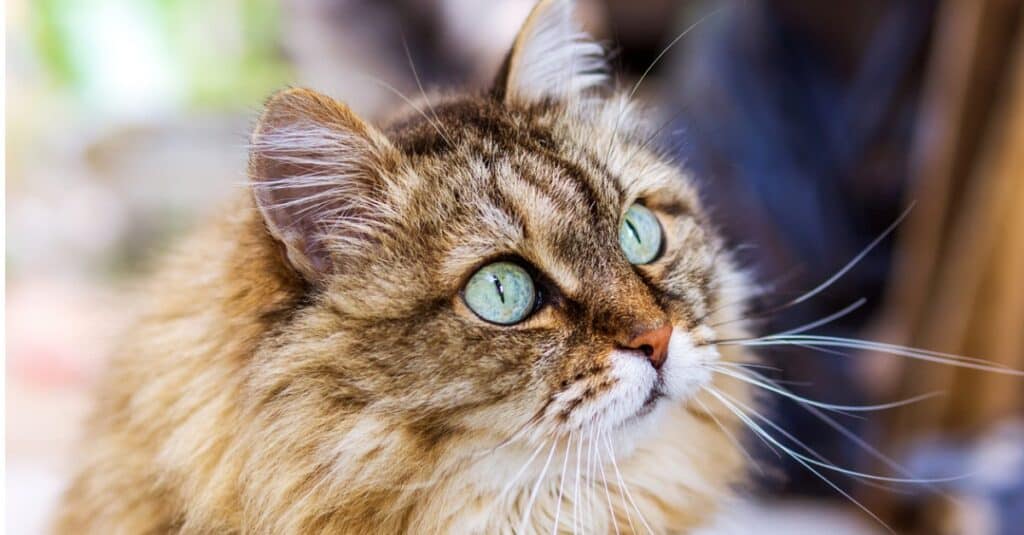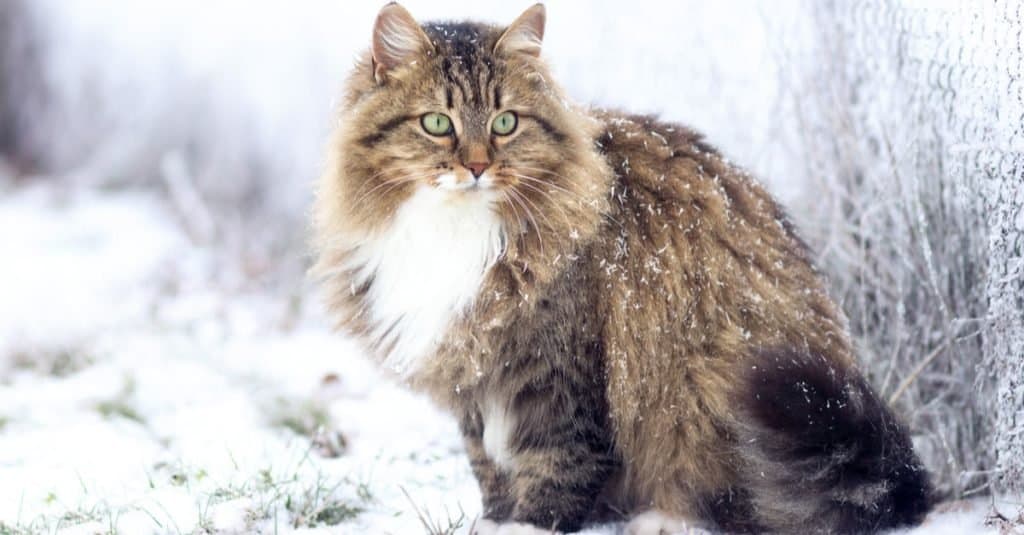Siberian
Felis catus
The Siberian cat is the most cold weather-resistant of all domestic cat species!
Advertisement
Siberian Scientific Classification
- Kingdom
- Animalia
- Phylum
- Chordata
- Class
- Mammalia
- Order
- Carnivora
- Family
- Felidae
- Genus
- Felis
- Scientific Name
- Felis catus
Read our Complete Guide to Classification of Animals.
Siberian Conservation Status
Siberian Facts
- Fun Fact
- The Siberian cat is the most cold weather-resistant of all domestic cat species!
- Other Name(s)
- Siberian Forest Cat, Moscow Longhair
- Temperament
- Affectionate, loving and loyal
- Diet
- Omnivore
View all of the Siberian images!
The Siberian cat, also known as the Siberian forest cat, is an ancient breed that dates back hundreds of years.
While popular in its native Russia, where it has become an important element of various fairy tales and folklore, the Siberian didn’t arrive in the United States until 1990, after the fall of the Soviet government. These friendly and people-oriented cats are among the most affectionate and playful breeds you can find.
See all of our expert product reviews.

Breed History
The Siberian cat breed dates back hundreds, possibly thousands, of years. Its known origin is Russia, but these cats were probably ancestors of Asian cats which were imported to Siberia to control the rodent population for settlers there. While Siberian cats are known to have existed since at least the 17th century, they may have developed thicker coats to adapt to the cold climate. Siberian cats earned a reputation for their expert abilities to hunt rats, and during that period spread throughout Russia.
Siberian cats are believed to be the ancestors of all modern breeds of long-haired cats, sharing similar traits with other breeds like the Norwegian forest cat. Siberians are the first recognized cat breed originating in Russia as of the late 1980s, and gained international registration in 1992. Meanwhile, a breeding program in the U.S. began in the early 1990s with the arrival of the first breeding pairs after the wall came down in communist Russia. While there are Siberians in the U.S., they are rare here due to import costs, but more common in Europe, and dubbed the national cat of Russia.
Traits: What to Know before You Buy
- The Siberian is a good-natured breed that seems to get along well with almost everyone, including people, dogs, and other cats. Their personality is laid back and friendly.
- Despite its calm nature, the Siberian cat is also a very playful and fun-loving breed. This cat will actively encourage playtime by bringing toys and balls to its owner. Some even enjoy playing fetch.
- This acrobatic breed also has a remarkable sense of balance and control. It will try to climb on almost any furniture that will support its weight – and even some that may not necessarily support it.
- Owners will need to keep up with the cat’s care. The Siberian cat will require frequent grooming, daily dental hygiene, weekly ear checks, and the occasional nail trimming.
- The thick and elegant fur coat is another of the Siberian’s appealing qualities. Breeders will accept almost any color or combination: white, black, blue, red, silver, and everything in between.
Personality
Unlike your typical cat breed, the Siberian thrives on people’s adoration. This cat will follow you from room to room and wait for you at the door when you come home. Unfortunately, the Siberian can be a nuisance when you’re trying to focus on your activities. It has the tendency to climb over computer keyboards or interrupt your reading.
But this is sometimes outweighed by their fun and playful nature, fearless attitude, and calm and laid-back personality, which should appeal to people of all ages. Since nothing much appears to frighten or ruffle them, this makes it a good choice for households with large dogs or young children.

©iStock.com/Алексей Филатов
Health and Entertainment for your Siberian
See all of our expert product reviews.
Size and Weight
The Siberian is a muscular and powerful cat, measuring 17 to 25 inches, with a big barreled chest and long ears. The cat’s typical weight is 15 to 20 pounds, though they can sometimes weigh up to 25 pounds.
Price
The price of a new Siberian kitten from a respectable breeder will probably cost an average of $1,200 to $2,000, but there are different options on both sides of the price spectrum. The cost can easily exceed more than $2,000 for a high-quality show cat but only a few hundred dollars for an adopted pet. This is in addition to the price of veterinary care, toys, food, and other common expenses.

©Marie Charouzova/Shutterstock.com
Kittens
Siberian kittens should be available for purchase at around the 12 to 16-week mark when they first receive their vaccines. Socialization and training should begin shortly after the kitten is brought home to ensure it becomes a well-behaved adult. Owners should expect a certain amount of rambunctiousness though. These are exceptionally energetic and playful animals, and their energy won’t necessarily diminish too much with age.
This breed will do most of its growth in the first 18 months when it will need high-quality kitten food to support its development, but due to continuously growing muscles, it may take up to five years to reach its full size.

©Just-Mila/Shutterstock.com
Lifespan
The Siberian cat has a normal lifespan of 11 to 15 years, but with a bit of luck and good health, it’s not uncommon for this breed to live around 18 years old. While generally healthy, the Siberian might be at risk of several health problems, including kidney disease, gum disease, cancer, and a potentially fatal heart disease called hypertrophic cardiomyopathy in which the heart becomes enlarged. This can appear at any age of the kitten’s life, beginning at a year old.
Ask your breeder for proof or certification that their cats have been tested for common health problems. While breeders cannot eliminate the risk of all health problems, they can ensure the best chance of a long, high-quality life. Regular checkups at the vet are also necessary to catch potential health problems as early as possible.

©Just-Mila/Shutterstock.com
Breed vs. Mixed
A purebred Siberian cat is characterized by a wedge-shaped head, long tufted ears, a thick tail, strong legs, large and tufted paws, and big round eyes with shades of green, yellow, or blue. The Siberian can be mixed with many different breeds of cat, including the closely related Norwegian forest cat and the Maine coon, whose thick, fluffy fur can produce many interesting patterns and combinations.

.
©fantom_rd/Shutterstock.com
Types of Siberian Cats and Colors
The Siberian cat has a very thick triple coat of fur, specialized for surviving in the frigid northern climates, that needs to be groomed a few times a week with a simple brush to remove loose hairs and prevent tangles and mats. The arrival of the annual shedding season in the spring and fall may necessitate more frequent grooming, possibly even once a day.
While there aren’t any distinctive types of Siberian cats, prospective owners may be impressed by the sheer variety of its coat. The Cat Fancier’s Association accepts all colors and combinations, including:
- All-white
- Mackerel patterned
- Colorpoint
- Black
- Blue
- Silver
- Cameo
- Tortoishell
- Smoke
- Tabby patterned
An interesting fact in the breed’s history is that it owns a colorpoint subspecies that is named after the main river in St. Petersburg–the Neva River. The colorpoint pattern, called Neva Masquerade, is characterized by a mask-like facial coloring. The Neva Masquerade colorpoint is centuries old. This specific subspecies has been preserved in a cat nursery in St. Petersburg since 1989. This breed always has blue eyes but otherwise is like all other Siberian cats.
View all 293 animals that start with SSiberian FAQs (Frequently Asked Questions)
Are Siberians herbivores, carnivores, or omnivores?
Siberians are Omnivores, meaning they eat both plants and other animals.
What Kingdom do Siberians belong to?
Siberians belong to the Kingdom Animalia.
What phylum to Siberians belong to?
Siberians belong to the phylum Chordata.
What class do Siberians belong to?
Siberians belong to the class Mammalia.
What family do Siberians belong to?
Siberians belong to the family Felidae.
What order do Siberians belong to?
Siberians belong to the order Carnivora.
What type of covering do Siberians have?
Siberians are covered in hair.
What genus do Siberians belong to?
Siberians belong to the genus Felis.
How many babies do Siberians have?
The average number of babies a Siberian has is 5.
What is an interesting fact about Siberians?
The Siberian is an exceptionally agile jumper!
What is the scientific name for the Siberian?
The scientific name for the Siberian is Felis catus.
Are Siberian cats really hypoallergenic?
The Siberian is considered to be one of the more hypoallergenic breeds. This is based on the fact that it produces a minimal amount of the strongest known cat allergen called Fel d 1, usually found in its saliva. Nevertheless, it should be noted that no breed of cat is 100% safe for all allergy sufferers. Individual reactions to any breed of cat will always vary, so be prepared for the possibility that the Siberian may agitate your allergies anyway.
Are Siberian cats cuddly?
The Siberian is among the more affectionate breeds of cat you can find. This breed loves to curl up on your lap for petting or grooming.
Can Siberian cats be indoor cats?
While the Siberian cat has traditionally been a bit of an outdoor animal, the modern urban or suburban setting might also pose some danger to your cat. Some experts recommend keeping it indoors at all times. It still might be a good idea to take your cat outdoors on a leash to get some exercise. Obesity is always a problem for any indoor pet.
How big is a Siberian?
The Siberian cat usually measures no more than 25 inches and 17 pounds, though some individuals are known to weigh up to 25 pounds. These are big, strong cats that love to jump around and explore.
Where can I buy a Siberian cat?
When purchasing a new kitten, it’s always a good idea to do your research in order to find a respectable breeder in your area with who you feel comfortable doing business. While specialty breeders are generally more expensive, their cats are also less likely to develop health problems, saving you money and grief later on. If price is a concern, however, then you might want to try an adoption or rescue shelter. These animals are usually well cared for and just need a loving home. Prospective owners should never do business with kitten mills and low-quality breeders, no matter how cheap the price, because their cats are more likely to develop serious health problems. If you’re looking into a pet store, you should be aware that they do not always sell purebred kittens, and the quality can vary.
Thank you for reading! Have some feedback for us? Contact the AZ Animals editorial team.
Sources
- Cat Fancier's Association, Available here: https://cfa.org/siberian/siberian-breed-standard/
- Cat Time, Available here: https://cattime.com/cat-breeds/siberian-cats#/slide/1
- The Happy Cat Site, Available here: https://www.thehappycatsite.com/siberian-cat/

















